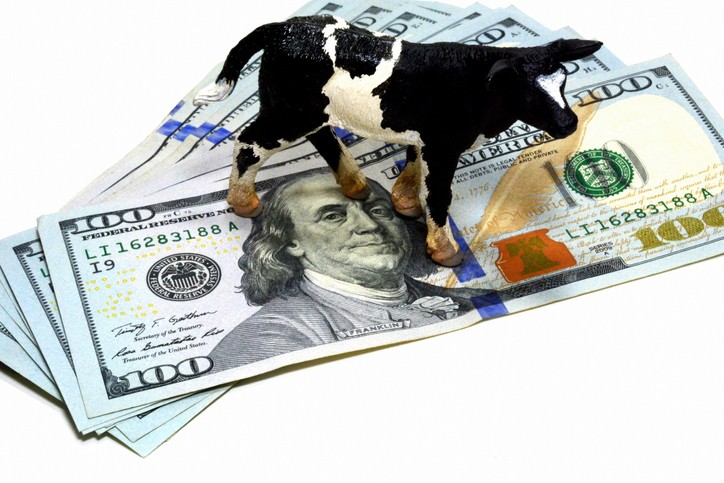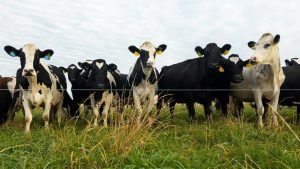
The Cheddar blocks closed Friday at $1.92 per pound, down 7.5 cents on the week, 42 cents above a year ago but 1.75 cents below their Jan. 2 perch.
The barrels finished the week and the month at $1.50, down 11 cents, 20 cents above a year ago, and 14.25 cents below their Jan. 2 closing.
There were no sales of block cheese last week at the CME but 43 for the month of January, down from 37 in December. Only 3 cars of barrel exchanged hands last week and 94 for the month, down from 103 in December.
The blocks were unchanged Monday but slipped a half-cent Tuesday, to $1.9150, as traders absorbed the drop in the morning’s Global Dairy Trade auction and awaited the afternoon’s December Dairy Products report from the USDA.
The barrels lost 4.5 cents Monday, falling to the lowest CME price since March 13, 2019, and set a record spread of 46.5 cents. They gained 1.5 cents Tuesday, and climbed to $1.47, 44.5 cents below the blocks.
FC Stone’s Dave Kurzawski wrote in Tuesday morning’s Early Morning Update that “barrel weakness personifies the milk ‘flush’ that becomes widely discussed this time of year. No doubt we have milk available. Certain regions are awash in milk already, like Idaho and California. Other areas, not so much. Either way, this barrel market is either the leading symbol of a larger bear trend developing or one final push lower.”
“Realistically, it seems to make sense that blocks come down somewhat,” says Kurzawski. “But in the same breath, $1.45 barrel market reads as too low. So, in a perfect dairy world, based on our analysis, we’d expect this spread to narrow with barrels catching a bid and blocks falling.”
Midwestern cheesemakers tell Dairy Market News that 2020 sales are meeting or beating expectations but the market remains “in flux” because of the large block-barrel price spread. Regional demand for both “is anything but unstable,” says DMN. Milk prices are holding just under class for the most part on slow trading. Stocks are generally balanced regionally and “mostly positive.”
Ample milk is keeping western vats busy. Demand is “moderate” and cheese is moving well through current contracts but “there is a capacity to sell more cheese.” Contacts are hoping for strong reorders now that the Super Bowl is behind us “to carry the cheese market into spring and the distant grilling season.”
The December cold storage report suggested that total cheese inventories were pulled down a bit nationwide but western inventories did not follow that pattern. American cheese stocks grew in the West and other natural cheese inventories were fairly stable.
Spot butter fell to $1.7750 per pound last Tuesday, lowest since Oct. 21, 2016, and 66 cents below its July 16, 2019, high of $2.4350. It rallied to close Friday at $1.90, up 4 cents on the week but 39 cents below a year ago; 53 cars sold on the week, 28 alone on Friday, and 82 on the month, up from 29 in December.
Monday’s butter was up a half-cent, with a whopping 37 cars sold, but then it reversed Tuesday and fell 2.5 cents, to $1.88.
“To churn or not to churn,” is the question facing Central butter plant managers, says DMN. Cream availability is abundant, widely available from the West, the mountain states, and locally. “As some butter producers continue to run full bore, locking away stores for the spring, others are checking production due to scant seasonal demand and current market bearishness.
The western butter market is experiencing pressures, partly caused by abundant stocks and not so much demand. Orders from retailers are stable but international sales seem almost idle.
Grade A nonfat dry milk saw a Friday close at $1.24 per pound, down 4.75 cents on the week but 23.75 cents above a year ago; 25 cars traded hands on the week, 92 for the month, up from 27 in December.
The powder lost a penny Monday and was down a penny and a half Tuesday, slipping to $1.2150, the lowest CME price since Nov. 11, 2019.
CME dry whey climbed to 38.50 cents per pound Wednesday, the highest price since Sept. 20, 2019, but closed Friday at 36.50 cents, unchanged on the week and 0.25 cents above a year ago; 6 cars exchanged hands on the week, 153 for the month, up from 88 in December.
The whey was unchanged both Monday and Tuesday, holding at Friday’s close.
GDT drops
Powder and butterfat values pulled the third Global Dairy Trade auction of 2020 down sharply, reversing the previous two upticks. The weighted average of products offered fell 4.7%, following the 1.7% rise on Jan. 21 and 2.8% rise on Jan. 7, as traders are apprehensive over the continuing fallout of the coronavirus outbreak.
Whole milk powder led the declines, dropping 6.2%, after it gained 2.4% on Jan. 21. Buttermilk powder was down 5.2% and anhydrous milkfat was down 4.5%, after falling 2.6% last time. Skim milk powder was down 4.2% after inching 0.7% higher last time.
Gains were led by rennet casein and GDT Cheddar, both up 6.0%, after the Cheddar was up 0.6% higher last time. Butter inched 0.2% higher, following a 5.5% jump in the last event.
FC Stone equated the GDT 80 percent butterfat butter price to $1.8841 per pound U.S., up fractionally from the last event. CME butter closed Tuesday at $1.88.
GDT Cheddar cheese equated to $1.9513 per pound, up 11.5 cents, and compares to Tuesday’s CME block Cheddar at $1.9150.
GDT skim milk powder averaged $1.3186 per pound and compares to $1.3770 last time. Whole milk powder averaged $1.3786, down from $1.4663. CME Grade A nonfat dry milk closed Tuesday at $1.2150 per pound.
Milk ratio slips
A lower All Milk price and higher feed prices pulled the December milk-feed price ratio down, ending five consecutive months of gain. The USDA’s latest Ag Prices report put the ratio at 2.55, down from 2.61 in November and compares to 2.07 in December 2018.
The index is based on the current milk price in relationship to feed prices for a dairy ration consisting of 51% corn, 8% soybeans and 41% alfalfa hay. Today, one pound of milk purchases 2.55 pounds of dairy feed containing that blend.
The U.S. All-Milk price averaged $20.70 per hundredweight, down 30 cents from November but is $4.10 above December 2018. California’s All Milk price was $19.80, up 30 cents from November and $3.27 above a year ago. Wisconsin’s, at $21.30, was down $1.10 from November but $5.10 above a year ago.
The national average corn price averaged $3.71 per bushel, up 3 cents from November and 17 cents per bushel above December 2018.
Soybeans averaged $8.70 per bushel, up 11 cents from November and 14 cents per bushel above a year ago.
Alfalfa hay averaged $175 per ton, up $2 from November but $4.00 per ton below a year ago.
Looking at the cow side of the ledger; the December cull price for beef and dairy combined averaged $59.30 per cwt., up $1.60 from November, $7.50 above December 2018, but is $12.30 below the 2011 base average of $71.60 per cwt.
























